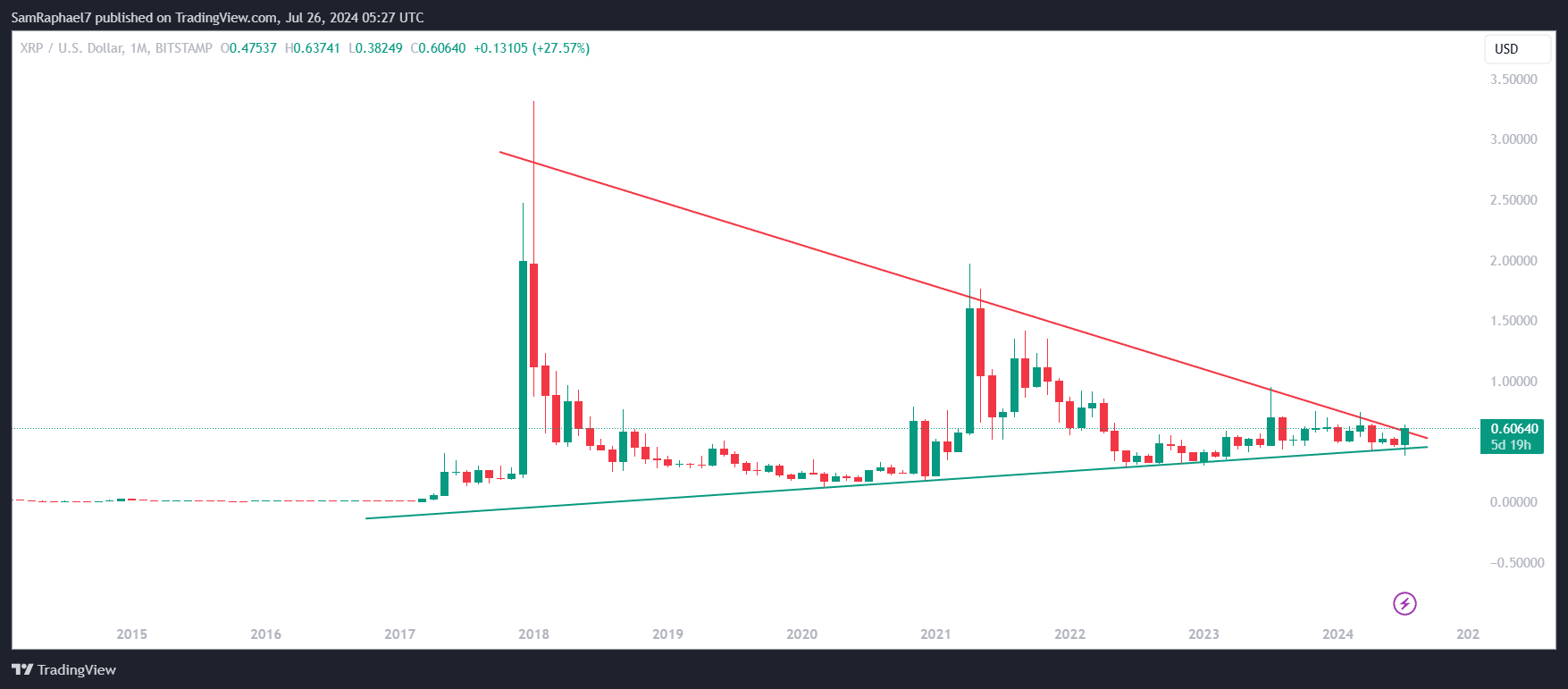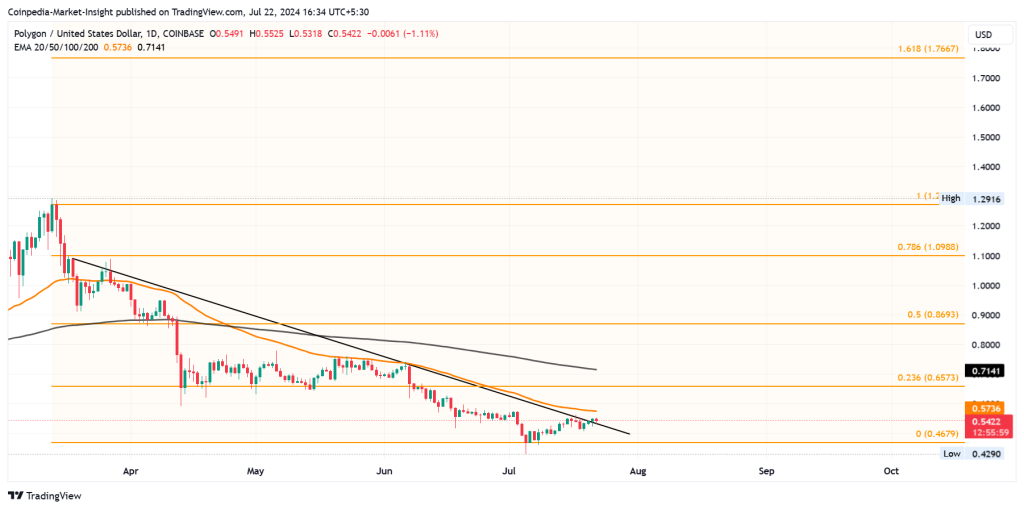Category: Forex News, News
Pound Sterling stabilizes above 1.2700 ahead of key events
Take advantage of the Special Price just for today!
50% OFF and access to ALL our articles and insights. Your coupon code
Subscribe to Premium
- GBP/USD moves sideways above 1.2700 in the European session on Tuesday.
- Mixed labor market data from the UK limits Pound Sterling’s upside.
- Market action could turn subdued ahead of Wednesday’s key macroeconomic events from the US.
Following a bearish start to the week, GBP/USD staged a rebound and stabilized above 1.2700. The pair’s technical outlook doesn’t point to a buildup of recovery momentum.
Although the US Dollar (USD) gathered strength on Monday, GBP/USD’s losses remained limited. The sharp decline seen in EUR/GBP showed that Pound Sterling was able to capture capital outflows out of the Euro following the European Parliament election.
British Pound PRICE This week
The table below shows the percentage change of British Pound (GBP) against listed major currencies this week. British Pound was the strongest against the Japanese Yen.
| USD | EUR | GBP | JPY | CAD | AUD | NZD | CHF | |
|---|---|---|---|---|---|---|---|---|
| USD | 0.46% | -0.10% | 0.25% | 0.11% | -0.19% | -0.29% | -0.08% | |
| EUR | -0.46% | -0.22% | 0.05% | -0.10% | -0.37% | -0.50% | -0.29% | |
| GBP | 0.10% | 0.22% | 0.40% | 0.12% | -0.15% | -0.28% | -0.07% | |
| JPY | -0.25% | -0.05% | -0.40% | -0.14% | -0.51% | -0.66% | -0.29% | |
| CAD | -0.11% | 0.10% | -0.12% | 0.14% | -0.26% | -0.41% | -0.19% | |
| AUD | 0.19% | 0.37% | 0.15% | 0.51% | 0.26% | -0.13% | 0.08% | |
| NZD | 0.29% | 0.50% | 0.28% | 0.66% | 0.41% | 0.13% | 0.21% | |
| CHF | 0.08% | 0.29% | 0.07% | 0.29% | 0.19% | -0.08% | -0.21% |
The heat map shows percentage changes of major currencies against each other. The base currency is picked from the left column, while the quote currency is picked from the top row. For example, if you pick the British Pound from the left column and move along the horizontal line to the US Dollar, the percentage change displayed in the box will represent GBP (base)/USD (quote).
Early Tuesday, the UK’s Office for National Statistics (ONS) reported that the ILO Unemployment Rate edged higher to 4.4% in the three months to April from 4.3%. In the same period, the Employment Change was -140,000. Meanwhile, annual wage inflation, as measured by the change in the Average Earnings Excluding Bonus, held steady at 6% to match the market expectation. Mixed labor market data seems to be making it difficult for GBP/USD to gain traction.
The US economic calendar will not offer any high-impact data releases on Tuesday. In case safe-haven flows dominate the action in financial markets in the American session, the USD could preserve its strength and not allow GBP/USD to stretch higher. Nevertheless, investors could refrain from taking large positions ahead of Wednesday’s US inflation data and the Federal Reserve’s (Fed) monetary policy announcements.
GBP/USD Technical Analysis
The Fibonacci 23.6% retracement level of the latest uptrend aligns as first support at 1.2700. In case GBP/USD falls below this level and confirms it as resistance, 1.2640 (100-day Simple Moving Average (SMA) and the 200-period SMA on the 4-hour chart) could be seen as next support before 1.2600 (psychological level, static level).
On the upside, immediate resistance is located at 1.2730 (lower limit of the ascending channel, 100-period SMA) ahead of 1.2800 (mid-point of the ascending channel, psychological level, static level).
Pound Sterling FAQs
The Pound Sterling (GBP) is the oldest currency in the world (886 AD) and the official currency of the United Kingdom. It is the fourth most traded unit for foreign exchange (FX) in the world, accounting for 12% of all transactions, averaging $630 billion a day, according to 2022 data. Its key trading pairs are GBP/USD, aka ‘Cable’, which accounts for 11% of FX, GBP/JPY, or the ‘Dragon’ as it is known by traders (3%), and EUR/GBP (2%). The Pound Sterling is issued by the Bank of England (BoE).
The single most important factor influencing the value of the Pound Sterling is monetary policy decided by the Bank of England. The BoE bases its decisions on whether it has achieved its primary goal of “price stability” – a steady inflation rate of around 2%. Its primary tool for achieving this is the adjustment of interest rates. When inflation is too high, the BoE will try to rein it in by raising interest rates, making it more expensive for people and businesses to access credit. This is generally positive for GBP, as higher interest rates make the UK a more attractive place for global investors to park their money. When inflation falls too low it is a sign economic growth is slowing. In this scenario, the BoE will consider lowering interest rates to cheapen credit so businesses will borrow more to invest in growth-generating projects.
Data releases gauge the health of the economy and can impact the value of the Pound Sterling. Indicators such as GDP, Manufacturing and Services PMIs, and employment can all influence the direction of the GBP. A strong economy is good for Sterling. Not only does it attract more foreign investment but it may encourage the BoE to put up interest rates, which will directly strengthen GBP. Otherwise, if economic data is weak, the Pound Sterling is likely to fall.
Another significant data release for the Pound Sterling is the Trade Balance. This indicator measures the difference between what a country earns from its exports and what it spends on imports over a given period. If a country produces highly sought-after exports, its currency will benefit purely from the extra demand created from foreign buyers seeking to purchase these goods. Therefore, a positive net Trade Balance strengthens a currency and vice versa for a negative balance.
- GBP/USD moves sideways above 1.2700 in the European session on Tuesday.
- Mixed labor market data from the UK limits Pound Sterling’s upside.
- Market action could turn subdued ahead of Wednesday’s key macroeconomic events from the US.
Following a bearish start to the week, GBP/USD staged a rebound and stabilized above 1.2700. The pair’s technical outlook doesn’t point to a buildup of recovery momentum.
Although the US Dollar (USD) gathered strength on Monday, GBP/USD’s losses remained limited. The sharp decline seen in EUR/GBP showed that Pound Sterling was able to capture capital outflows out of the Euro following the European Parliament election.
British Pound PRICE This week
The table below shows the percentage change of British Pound (GBP) against listed major currencies this week. British Pound was the strongest against the Japanese Yen.
| USD | EUR | GBP | JPY | CAD | AUD | NZD | CHF | |
|---|---|---|---|---|---|---|---|---|
| USD | 0.46% | -0.10% | 0.25% | 0.11% | -0.19% | -0.29% | -0.08% | |
| EUR | -0.46% | -0.22% | 0.05% | -0.10% | -0.37% | -0.50% | -0.29% | |
| GBP | 0.10% | 0.22% | 0.40% | 0.12% | -0.15% | -0.28% | -0.07% | |
| JPY | -0.25% | -0.05% | -0.40% | -0.14% | -0.51% | -0.66% | -0.29% | |
| CAD | -0.11% | 0.10% | -0.12% | 0.14% | -0.26% | -0.41% | -0.19% | |
| AUD | 0.19% | 0.37% | 0.15% | 0.51% | 0.26% | -0.13% | 0.08% | |
| NZD | 0.29% | 0.50% | 0.28% | 0.66% | 0.41% | 0.13% | 0.21% | |
| CHF | 0.08% | 0.29% | 0.07% | 0.29% | 0.19% | -0.08% | -0.21% |
The heat map shows percentage changes of major currencies against each other. The base currency is picked from the left column, while the quote currency is picked from the top row. For example, if you pick the British Pound from the left column and move along the horizontal line to the US Dollar, the percentage change displayed in the box will represent GBP (base)/USD (quote).
Early Tuesday, the UK’s Office for National Statistics (ONS) reported that the ILO Unemployment Rate edged higher to 4.4% in the three months to April from 4.3%. In the same period, the Employment Change was -140,000. Meanwhile, annual wage inflation, as measured by the change in the Average Earnings Excluding Bonus, held steady at 6% to match the market expectation. Mixed labor market data seems to be making it difficult for GBP/USD to gain traction.
The US economic calendar will not offer any high-impact data releases on Tuesday. In case safe-haven flows dominate the action in financial markets in the American session, the USD could preserve its strength and not allow GBP/USD to stretch higher. Nevertheless, investors could refrain from taking large positions ahead of Wednesday’s US inflation data and the Federal Reserve’s (Fed) monetary policy announcements.
GBP/USD Technical Analysis
The Fibonacci 23.6% retracement level of the latest uptrend aligns as first support at 1.2700. In case GBP/USD falls below this level and confirms it as resistance, 1.2640 (100-day Simple Moving Average (SMA) and the 200-period SMA on the 4-hour chart) could be seen as next support before 1.2600 (psychological level, static level).
On the upside, immediate resistance is located at 1.2730 (lower limit of the ascending channel, 100-period SMA) ahead of 1.2800 (mid-point of the ascending channel, psychological level, static level).
Pound Sterling FAQs
The Pound Sterling (GBP) is the oldest currency in the world (886 AD) and the official currency of the United Kingdom. It is the fourth most traded unit for foreign exchange (FX) in the world, accounting for 12% of all transactions, averaging $630 billion a day, according to 2022 data. Its key trading pairs are GBP/USD, aka ‘Cable’, which accounts for 11% of FX, GBP/JPY, or the ‘Dragon’ as it is known by traders (3%), and EUR/GBP (2%). The Pound Sterling is issued by the Bank of England (BoE).
The single most important factor influencing the value of the Pound Sterling is monetary policy decided by the Bank of England. The BoE bases its decisions on whether it has achieved its primary goal of “price stability” – a steady inflation rate of around 2%. Its primary tool for achieving this is the adjustment of interest rates. When inflation is too high, the BoE will try to rein it in by raising interest rates, making it more expensive for people and businesses to access credit. This is generally positive for GBP, as higher interest rates make the UK a more attractive place for global investors to park their money. When inflation falls too low it is a sign economic growth is slowing. In this scenario, the BoE will consider lowering interest rates to cheapen credit so businesses will borrow more to invest in growth-generating projects.
Data releases gauge the health of the economy and can impact the value of the Pound Sterling. Indicators such as GDP, Manufacturing and Services PMIs, and employment can all influence the direction of the GBP. A strong economy is good for Sterling. Not only does it attract more foreign investment but it may encourage the BoE to put up interest rates, which will directly strengthen GBP. Otherwise, if economic data is weak, the Pound Sterling is likely to fall.
Another significant data release for the Pound Sterling is the Trade Balance. This indicator measures the difference between what a country earns from its exports and what it spends on imports over a given period. If a country produces highly sought-after exports, its currency will benefit purely from the extra demand created from foreign buyers seeking to purchase these goods. Therefore, a positive net Trade Balance strengthens a currency and vice versa for a negative balance.
Discover more from BIPNs
Subscribe to get the latest posts sent to your email.
Written by : Editorial team of BIPNs
Main team of content of bipns.com. Any type of content should be approved by us.
Share this article:
Discover more from BIPNs
Subscribe to get the latest posts sent to your email.











